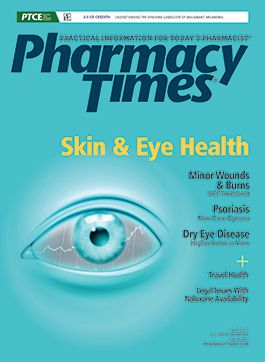Publication
Article
Pharmacy Times
Self-Treatment of Minor Wounds and Burns
Author(s):
Minor wounds and burns are common, so it is important to know how to manage these injuries and to have the proper first-aid products readily available.
Minor wounds and burns are common, so it is important to know how to manage these injuries and to have the proper first-aid products readily available. Proper wound care is critical to healing and to reducing the possibility of scar formation and secondary bacterial skin infections.1 Immediately after an injury occurs, wound healing begins in 3 phases: inflammation, proliferation, and maturation (remodeling).1 Pharmacists can assist patients seeking guidance on the various OTC first-aid products for managing and treating minor wounds and burns, as well as remind patients about proper wound care protocol to optimize wound healing and minimize wound complications.
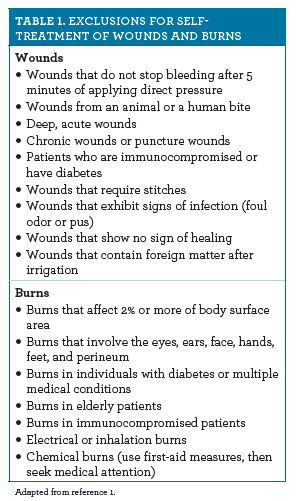
A host of OTC first-aid products are available for self-treating minor wounds, such as scrapes, scratches, cuts, and burns. Pharmacists can ascertain the appropriateness of self-treatment and, if necessary, advise patients to seek medical care from their primary care provider (PCP) (Table 11). Because certain pharmacologic agents, medical conditions, and other factors may hinder or impair healing, pharmacists should remind patients about the importance of adhering to proper wound care protocol for minor wounds and burns. Patients should be encouraged to immediately seek further medical care from their PCP, if warranted, especially if wounds show signs of infection or do not heal (Table 21,7).1-4
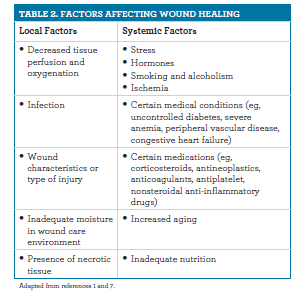
CLASSIFICATION OF WOUNDS AND BURNS
Assessing the type and severity of a wound or burn is critical to choosing the best care protocol and in deciding if self-treatment is appropriate. Typically, wounds are classified according to their acuity and depth.1 Acute wounds can be classified as abrasions, punctures, or lacerations and are usually due to trauma. With proper care, these wounds generally heal within 1 month in healthy adults.1 Typically caused by a rubbing or friction injury, abrasions involve the epidermis.1,4 Punctures result from a sharp object piercing the epidermis, the dermis, and possibly deeper tissues.1,4 Lacerations are caused by sharpedged objects that have pierced various layers of skin.1,4 In general, if acute wounds such as abrasions, lacerations, and puncture wounds do not extend beyond the dermis, self-care is deemed appropriate.1 Patients with chronic wounds should always be encouraged to immediately seek medical attention for proper care to prevent complications such as infection.
Superficial and some superficial partial-thickness burn injuries are the only types of burns that are appropriate for self-treatment.1 Individuals with deeper burns, such as chemical or electrical burns, should always be referred for medical evaluation and treatment.1
FIRST-AID PRODUCTS FOR MINOR WOUNDS AND BURNS
In general, the goals of wound and burn care are to promote healing, prevent infection and complications, provide physical protection, and minimize the risk of scarring.1 The common protocol for self-treatment of minor wounds and burns should follow a stepwise approach, including cleaning the damaged area, selectively using antiseptics and antibiotics, and closing or covering the area with an appropriate dressing (tables 33-6 and 4).1
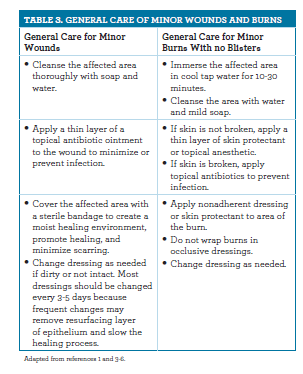
OTC wound care products available for self-treatment of wound and burn care include topical antibiotics (ie, bacitracin, neomycin, and polymyxin B sulfate), wound irrigants, wound antiseptics, skin protectants, and local anesthetics. The various types of bandages include medicated ones with topical antibiotics and products that can help to reduce scarring.1 In addition, bandages are available in waterproof, liquid, and latex-free forms. In some cases, patients experiencing pain associated with a minor burn or wound may benefit from taking an OTC nonsteroidal anti-inflammatory drug or acetaminophen on a short-term basis if appropriate and no contraindications are present.1
WOUND IRRIGATION PRODUCTS AND FIRST-AID ANTISEPTICS
Wound irrigation may be warranted to clean the wound surface if dirt or debris is present.1 A normal saline solution or a mild soap and water can be used for this process. In some cases, mechanical removal of debris with clean gauze is sometimes neccessary.1 In addition, numerous topical antiseptics are available to disinfect the skin. They should be applied only to intact skin up to the edges of the wound.1 Examples of first-aid antiseptics include ethyl alcohol (48%-95%), isopropyl alcohol (50%-91.3%), iodine topical solution USP, iodine tincture USP, povidone/iodine complex (5%- 10%), camphorated phenol, quaternary ammonium compounds, and topical hydrogen peroxide solution (0.13%).1
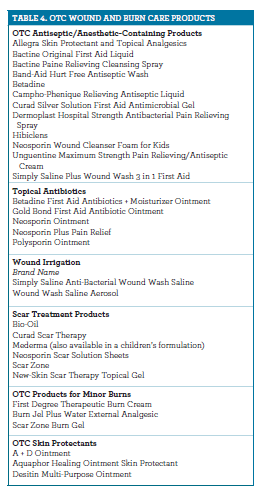
TOPICAL FIRST-AID ANTIBIOTICS
Topical OTC antibiotics are indicated for preventing infection in minor cuts, wounds, scrapes, and burns and should be applied after a wound has been cleaned and covered with a sterile dressing.1 Topical antibiotics include polymyxin B and a combination of bacitracin, neomycin, and polymyxin B sulfate. Some topical antibiotics also contain the anesthetic lidocaine, and some manufacturers market medicated bandages that contain a topical antibiotic for added convenience. Some first-aid products are available in small portable containers or single-use doses for mobile first aid.
SKIN PROTECTANTS
Skin protectants, such as allantoin and white petrolatum, are recognized by the FDA as safe and effective for the temporary protection of minor burns, but they provide only symptomatic relief.1 Skin protectants shield burns from mechanical irritation caused by friction, prevent drying of the stratum corneum, and minimize the pain associated with minor burns.1
TOPICAL ANESTHETICS
The pain associated with minor burns may be relieved with the use of topical anesthetics, which inhibit the transmission of pain signals from pain receptors and are typically applied no more than 3 or 4 times a day, as needed.1 Pain relief after application of OTC topical anesthetics typically lasts 15 to 45 minutes.1 The 2 most common topical anesthetics found in OTC products are benzocaine (5 % to 20%) and lidocaine (2% to 5%).1
END NOTE
For wounds and burns to heal properly, proper care is essential. Results from various studies have demonstrated that uncovered wounds are at greater risk of scarring, infection, and re-injury.1,5-7 Wound care should include covering the wound to create a moist healing environment. This is now considered the standard of care because it appears to accelerate healing and may minimize scarring and the likelihood of infection.1,5-7 Typically, dressings should be changed every 3 to 5 days, unless otherwise directed, because frequent dressing changes may remove resurfacing epithelial layers and may hinder or slow healing.1,5,6
Patients should be directed to continue using wound dressings until the wound shows signs of healing and should always be advised to seek medical care for wounds that do not exhibit signs of healing after 5 days of self-treatment or if the wound shows signs of infection.1 For minor burns, patients should be reminded not to use ice because it may cause vasoconstriction and make the burn worse.1,8 If a burn does not exhibit signs of healing, appears to worsen, or shows signs of infection after 7 days of treatment, patients should be advised to seek further medical care.1 During counseling, pharmacists can suggest that patients always have a first-aid kit handy in case of an emergency and check it regularly to ensure that its contents have not expired. Preassembled kits can be purchased, or patients can assemble them themselves. The American Red Cross recommends that first-aid kits contain the following for wound/burn care: antiseptic, antibiotic ointment, a blanket, a cold pack, disposable gloves, bandages of various sizes, adhesive tape, gauze pads, roller gauze, triangular bandage, hand cleaner, plastic bags, scissors, tweezers, a small flashlight with extra batteries, and activated charcoal.9
Many kits also contain medications such as oral and topical antihistamines, OTC topical hydrocortisone cream, OTC pain relievers, and calamine lotion.9 Pharmacists can also recommend a helpful educational resource on wound care (redcross.org/email/ safetynet/v1n9/firstaid.asp) from the American Red Cross. It provides handy first-aid tips and the 10 most common myths about first aid.
Ms. Terrie is a clinical pharmacist and medical writer based in Haymarket, Virginia.
References
- Bernard D. Minor burns, sunburns and wounds. In: Berardi R, Newton G, McDermott JH, et al, eds. Handbook of Nonprescription Drugs. 18th ed. Washington, DC: American Pharmacists Association; 2015.
- Lacerations. Merck Manual for Healthcare Professionals Online Edition http://www.merckmanuals.com/professional/injuries-poisoning/lacerations/lacerations Accessed April 2, 2017.
- Guo S, DiPietro LA. Factors Affecting Wound Healing. Journal of Dental Research. 2010;89(3):219-229. doi:10.1177/0022034509359125.
- Nicks BA, Ayello EA, Woo K, Nitzki-George D, Sibbald RG. Acute wound management: revisiting the approach to assessment, irrigation, and closure considerations. International Journal of Emergency Medicine. 2010;3(4):399-407. doi:10.1007/s12245-010-0217-5.
- How to clean and protect a cut or scratch in 2 simple steps. Band Aid website. https://www.band-aid.com/responding-to-first-aid-situations/emergency-situations/penetrating-objects Accessed April 2, 2017.
- Proper wound care. Neosporin website. neosporin.com/wound-care/wound-care-first-aid-kit. Accessed April 1, 2017.
- Junker JPE, Kamel RA, Caterson EJ, Eriksson E. Clinical Impact Upon Wound Healing and Inflammation in Moist, Wet, and Dry Environments. Advances in Wound Care. 2013;2(7):348-356. doi:10.1089/wound.2012.0412.
- Minor burns. Medline Plus website. https://medlineplus.gov/ency/patientinstructions/000662.htm. Accessed April 2, 2017.
- Anatomy of a first aid kit. American Red Cross website. redcross.org/prepare/location/home-family/get-kit/anatomy. Accessed April 3, 2017.
